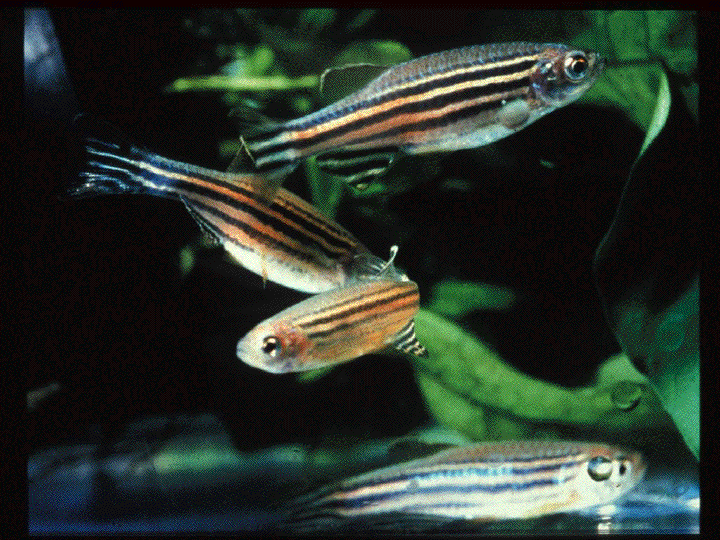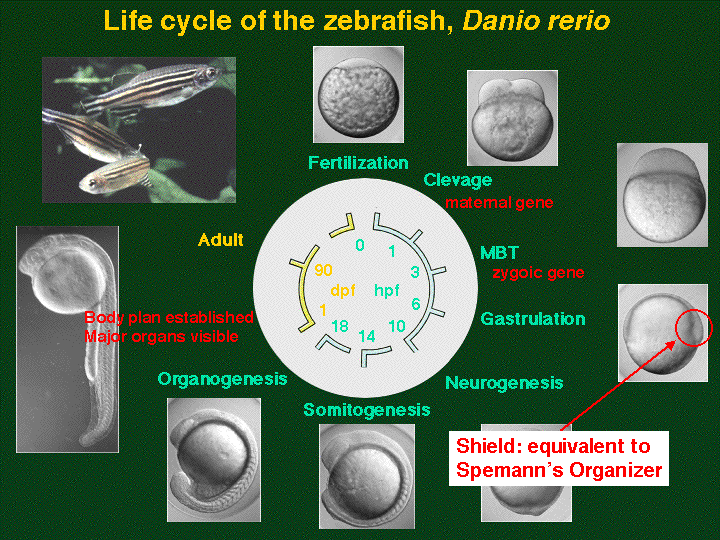Molecular mechanisms of the formation of Spemann organizer and
coordinate regulation of cell movement during gastrulation
Introduction
The aim of this research project is to extend further our
knowledge and experience obtained from the
cytokine research and applied them to
elucidation of the mechanisms by which cells of developing zebrafish
or mice respond to secreted signaling factors including cytokines to
specify cell fate and cell behavior, in particular axis
determination, gastrulation, and regionalization. The formation of
Spemann organizer is one of the most important steps in dorsoventral
axis determination in vertebrate development. We have isolated a
novel zebrafish homeobox gene,
dharma, specifically expressed
in Nieuwkoop center and essential for organizer formation and
forebrain formation. The aim of this projects is the elucidation of
the molecular mechanisms involved in organizer formation,
gastrulation. We will apply the findings in zebrafish to mouse by
performing gene-targeting of each responsible gene. The final goal of
this project is the application of our findings to the understanding
of the molecular mechanisms and control of human diseases. For this
purpose, we are currently performing several projects as follows:
Previous studies
Our studies on cell cleavage after fertilaization have revealed
that asymmetric p38 activation on one side of the blastodisc required
for symmetric and synchronous cleavage (J. Cell Biol. 150:1335-1347,
2000). Our results suggest that dorsal determinants directly or
indirectly induce asymmetric p38 activation which seems to be
required for cleavage in only future dorsal side. to understand the
molecular mechanisms of early development, we have identified several
zebrafisf genes, such as dharma, dkk-1, ifez, fezl, pnx, and stat3.
Among these two genes that are required for gastrulation, both of
which are down stream of maternal Wnt/b-catenin pathway. We found
that a novel zebrafish homeobox gene, dharma, which is induced
by maternal Wnt/b-catenin pathway and capable of inducing the
organizer ectopically (Genes & Development, 12: 2345-2353, 1998).
Furthermore, dharma gene was found to be encoded by bozozok locus
(Development, 126:1427-1438, 1999), establishing that dharma/bozozok
is essential gene for gastrula organiser formation. In fact,
dharma/boz and squint/nodal cooperatively induces organizer specific
genes, such as goosecoid, chordin and dkk-1 (Mech. of Dev. 91,
293-303, 2000). We also found that Stat3 is activated in the
dorsal region in a manner dependent on the maternal Wnt/b-catenin
pathway. Most important finding is that Stat3 controls cell movements
during gastrulation without affecting early cell fate specification
(Developmental Cells, 2: 363-375, 2002).
Projects
1) Identification and cloning of molecules involved in
dharma-induced organizer
formation, forebrain formation and neural development in zebra fish
utilizing subtraction, expression cloning and mutagenesis.
(zebrafish)
2) Elucidation of the roles of the
gp130/JAK /STAT signal
transduciton pathway in gastrulation cell movements and
identification of the ligand for gp130 and targets genes of the
JAK/STAT3 signals involved in cell movements. (zebrafish and mouse)
3) Elucidation of the roles of MAPK, JNK and p38 and upstream
signaling molecules related to these MAP kinase family molecules in
development. (zebrafish and mouse)
4) Identification of dorsal determinants. (zebrafish)
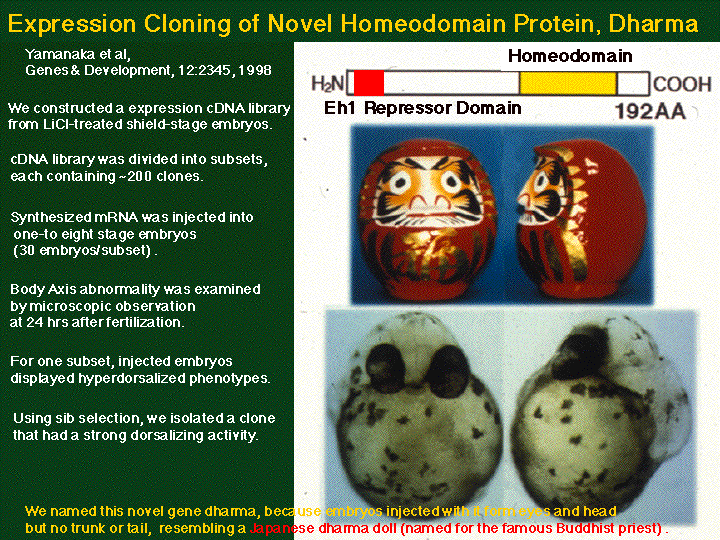
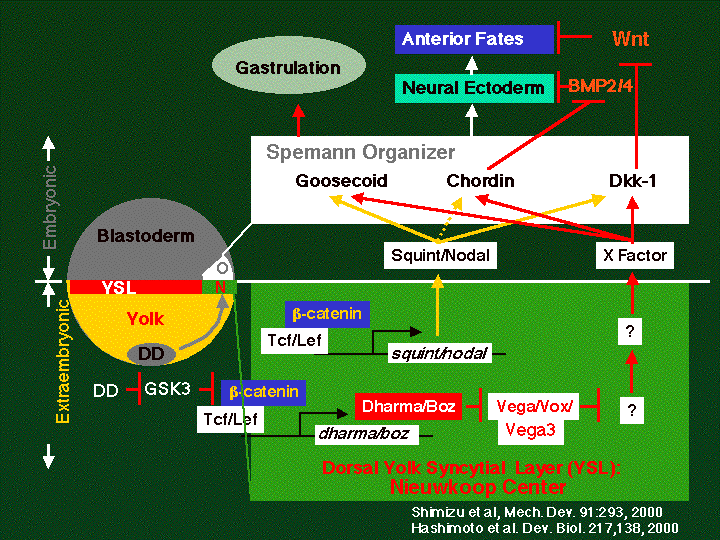
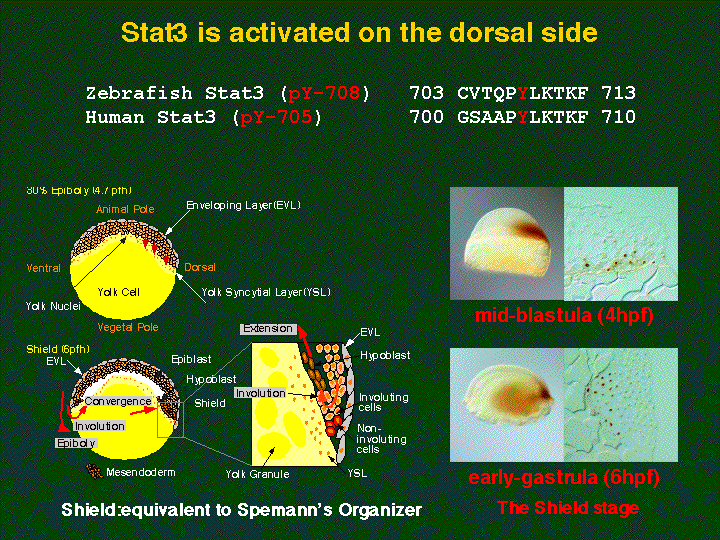
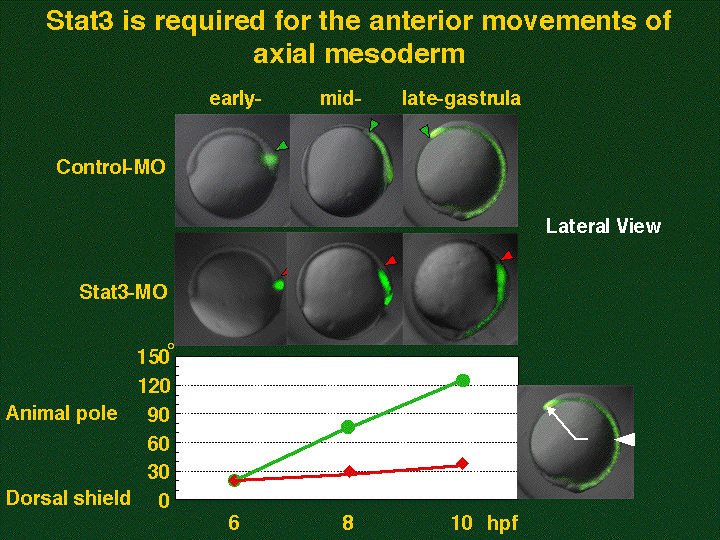
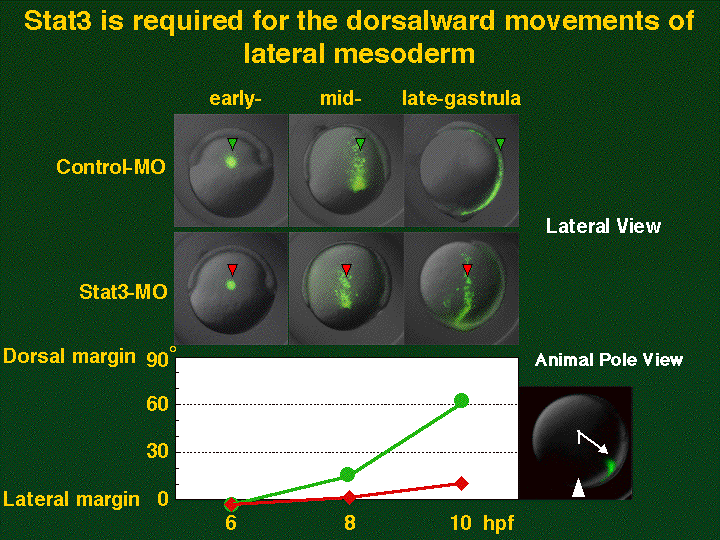
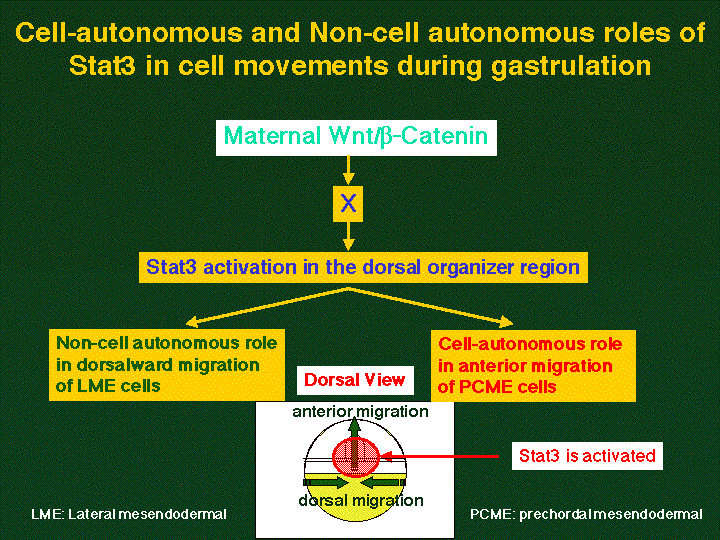
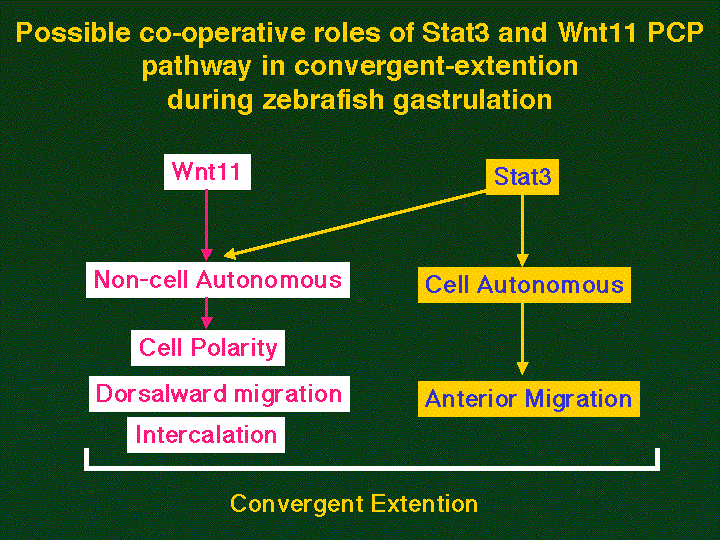
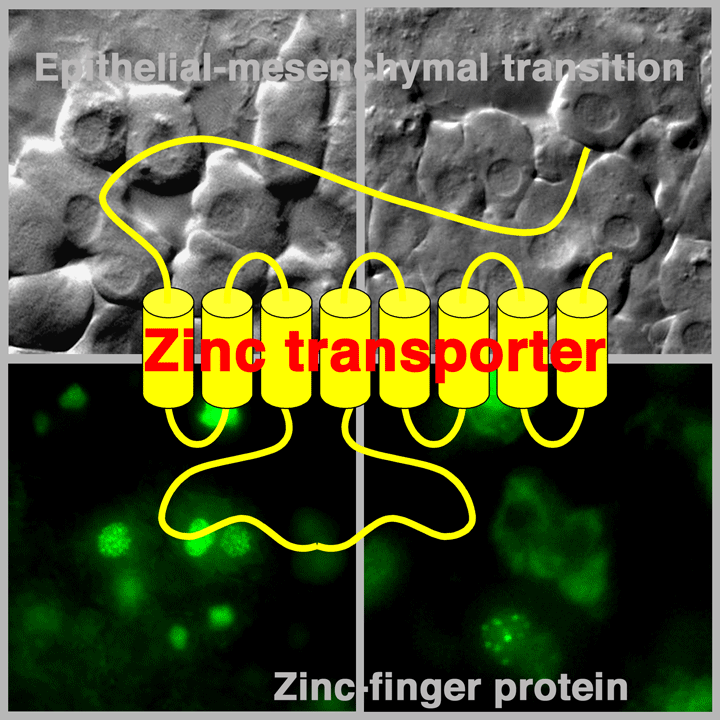
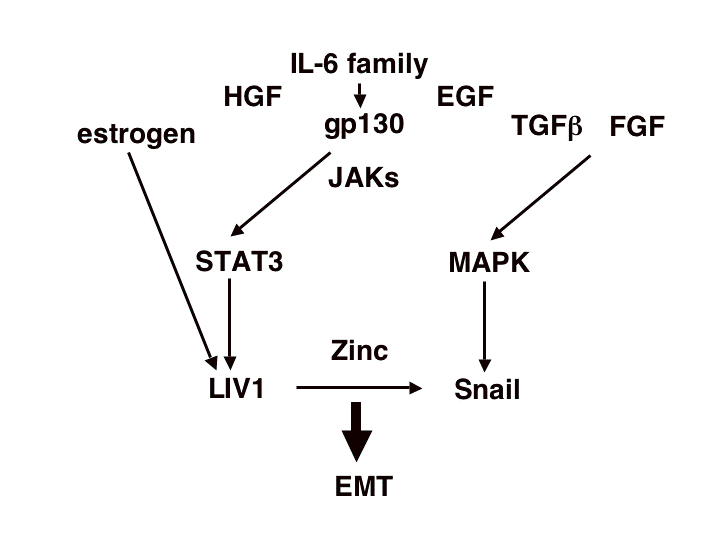
Publication
- Yamashita, S., C. Miyagi, T. Fukada, N. Kagara, Y.-S. Che
& T. Hirano. Zinc transporter LIVI controls
epithelial-mesenchymal transition in zebrafish gastrula organizer.
Nature, AOP, published
online 5 May 2004;
doi:10.1038/nature02545
- Yamashita, S., C. Miyagi, A. Carmany-Rampey, T. Shimizu, R.
Fujii, A. F. Schier and T. Hirano. Stat3 controls cell movements
during zebrafish gastrulation. Dev. Cell. 2: 363-375,
2002.(PubMed)
- Ryu, S.-L., R. Fujii, Y. Yamanaka, T. Shimizu, T. Yabe, T.
Hirata, M. Hibi, and T. Hirano. Regulation of
dharma/bozozok
by the Wnt pathway. Dev. Biol. 2001 231:397-409, 2001
(PubMed)
- Muraoka, O., Ichikawa, H., Shi, H., Okamura, S., Taira, E.,
Higuchi, H., Hirano, T., Hibi, M., and Miki, N. Kheper, a novel
ZFH/dEF1 family, regulates the development of the neuroectoderm of
zebrafish (Danio rerio). Dev. Biol. 228:29-40,
2000.(PubMed)
- Park, H-C., Kim, C-H., Bae, Y-K., Yeo, S-Y., Kim, S-H., Hong,
S-K., Shin, J., Hibi, M., Hirano, T., Miki, N., Chitnis, A.B., and
Huh, T-L. Analysis of upstream elements in the HuC promoter leads
to the establishment of transgenic zebrafish with fluorescent
neurons. Dev. Biol. 227:279-293, 2000.
(PubMed)
- Fujii, R., S. Yamashita, M. Hibi, and T. Hirano. Asymmetric
p38 activation in zebrafish; its possible role in symmetric and
synchronous cleavage. J. Cell Biol. 150:1335-1347, 2000
(PubMed)
(Full
Text in JCB). This is mentioned in
the "In
Brief" of the JCB.
- Hashimoto, H., T., Yabe, T. Hirata, T. Shimizu, Y.-K. Bae, Y.
Yamanaka, T. Hirano, and M. Hibi. Expression of the zinc finger
gene fez-like in zebrafish forebrain. Mechanisms of
Development, 97:191-195, 2000
(PubMed)
- Hirata, T., Y. Yamanaka, S.-L. Ryu, T. Shimizu, T. Yabe, M.
Hibi, and T. Hirano. Novel mix-family homeobox genes in zebrafish
and their differential regulation. BBRC, 271:603-609,
2000.(PubMed).
- Itoh, M., Yoshida, Y., Nishida, K., Narimatsu, M., Hibi, M.,
and Hirano, T. A role of Gab1 for heart, placenta, and skin
development, and growth factors- and cytokines-induced ERK MAP
kinase activation. Mol. Cell. Biol. 20, 3695-3704,
2000.(PubMed)(Abstract)(Full
Text in MCB)
- Shimizu, T., Y. Yamanaka, S.-L. Ryu, H. Hashimoto, T. Yabe, T.
Hirata, Y.-K. Bae, M. Hibi, and T. Hirano. Cooperative roles of
Bozozok/Dharma
and Nodal-related proteins in the formation of the dorsal
organizer in zebrafish. Mechanisms of Development, 91,
293-303,
2000.(Full
Text)(PubMed)
- Hashimoto, H., M. Itoh, Y. Yamanaka, S. Yamashita, T. Shimizu,
L. Solnica-Krezel, M. Hibi, and T. Hirano. Zebrafish Dkk1
Functions in Forebrain Specification and Axial Mesendoderm
Formation. Developmental Biology 217, 138-152,
2000.(Abstract)(PubMed)
- Fekany, K., Y. Yamanaka, T. Leung, H. I. Sirotkin, J.
Topczewski, M. A. Gates, M. Hibi, A. Renucci, D. Stemple, A.
Radbill, A. F. Schier, W. Driver, T. Hirano, W. S. Talbot, and L.
Solnica-Krezel. The zebrafish bozozok locus encodes
Dharma,
a homeodomain protein essential for induction of gastrula
organizer and dorsoanterior embryonic structures.
Development, 126:1427-1438, 1999.
(Development),
(PubMed)
- Kim, C.-H., Y.-K. Bae, Y. Yamanaka, S. Yamashita, T. Shimizu,
R. Fujii, H.-C. Park, S.-Y. Yeo, T.-L. Huh, M. Hibi, and T.
Hirano. Overexpression of neurogenin induces extopic expression of
HuC in zebrafish. Neuroscience Letters 239:113-116,
1997.(PubMed)
- Yamanaka, Y., T. Mizuno, Y. Sasai, M. Kishi, H. Takeda, C.-H.
Kim, M. Hibi and T. Hirano. A novel homeobox gene, dharma, can
induce the organizer in a non-cell-autonomous manner. Genes
& Development, 12: 2345-2353,
1998.(Abstract)(PubMed)
(Full
Text in G & D)
THE FISH NET: An access to Zebrafish Research Databases in North
America, Europe and Asia
